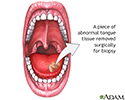Tongue biopsy
Biopsy - tongue
A tongue biopsy is a minor surgery that is done to remove a small piece of the tongue. The tissue is then examined under a microscope.
How the Test is Performed
A tongue biopsy can be done using a needle.
- You will get numbing medicine at the place where the biopsy is to be done.
- The health care provider will gently insert the needle into the tongue and remove a tiny piece of tissue.
Some types of tongue biopsies remove a thin slice of tissue. Medicine to numb the area (local anesthetic) will be used. Others are done under general anesthesia, (allowing you to be asleep and pain-free) so that a larger area may be removed and examined.
How to Prepare for the Test
You may be told not to eat or drink anything for several hours before the test.
How the Test will Feel
Your tongue is very sensitive so a needle biopsy may be uncomfortable even when numbing medicine is used.
Your tongue can be tender or sore, and it may feel slightly swollen after the biopsy. You may have stitches or an open sore where the biopsy was done.
Why the Test is Performed
The test is done to find the cause of abnormal growths or suspicious-looking areas of the tongue.
Normal Results
The tongue tissue is normal when examined.
What Abnormal Results Mean
Abnormal results may mean:
- Amyloidosis
- Tongue (oral) cancer
- Viral ulcer
- Benign tumors
Risks
Risks for this procedure include:
- Bleeding
- Infection
- Swelling of the tongue (can obstruct the airway and cause breathing difficulty)
Complications from this procedure are rare.
References
Azzoli CG, Birnbaum AE, Constantinou M, Ollila TA. Other solid tumors (head and neck, sarcomas, melanoma, unknown primary). In: Wing EJ, Schiffman FJ, eds. Cecil Essentials of Medicine. 10th ed. Philadelphia, PA: Elsevier; 2022:chap 62.
Ellis E, Huber MA. Principles of differential diagnosis and biopsy. In: Hupp JR, Ellis E, Tucker MR, eds. Contemporary Oral and Maxillofacial Surgery. 7th ed. Philadelphia, PA: Elsevier; 2019:chap 22.
Wenig BM. Neoplasms of the pharynx. In: Wenig BM, ed. Atlas of Head and Neck Pathology. 3rd ed. Philadelphia, PA: Elsevier; 2016 chap 10.
Review Date: 3/1/2023







